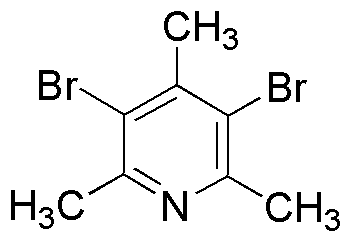3,5-Dibromo-2,4,6-trimethylpyridine is widely utilized in research focused on:
- Agricultural Chemistry: This compound serves as a key intermediate in the synthesis of agrochemicals, particularly herbicides and pesticides, enhancing crop protection and yield.
- Pharmaceutical Development: It is used in the formulation of various pharmaceuticals, contributing to the development of effective drugs with improved bioavailability.
- Material Science: The compound is employed in creating specialized polymers and resins, which offer superior thermal and chemical resistance for industrial applications.
- Analytical Chemistry: It acts as a reagent in analytical methods, aiding in the detection and quantification of other chemical substances in complex mixtures.
- Environmental Studies: Researchers utilize this compound to study its behavior and degradation in various environmental conditions, helping to assess its ecological impact.
General Information
Properties
Safety and Regulations
Applications
3,5-Dibromo-2,4,6-trimethylpyridine is widely utilized in research focused on:
- Agricultural Chemistry: This compound serves as a key intermediate in the synthesis of agrochemicals, particularly herbicides and pesticides, enhancing crop protection and yield.
- Pharmaceutical Development: It is used in the formulation of various pharmaceuticals, contributing to the development of effective drugs with improved bioavailability.
- Material Science: The compound is employed in creating specialized polymers and resins, which offer superior thermal and chemical resistance for industrial applications.
- Analytical Chemistry: It acts as a reagent in analytical methods, aiding in the detection and quantification of other chemical substances in complex mixtures.
- Environmental Studies: Researchers utilize this compound to study its behavior and degradation in various environmental conditions, helping to assess its ecological impact.
Documents
Safety Data Sheets (SDS)
The SDS provides comprehensive safety information on handling, storage, and disposal of the product.
Product Specification (PS)
The PS provides a comprehensive breakdown of the product’s properties, including chemical composition, physical state, purity, and storage requirements. It also details acceptable quality ranges and the product's intended applications.
Certificates of Analysis (COA)
Search for Certificates of Analysis (COA) by entering the products Lot Number. Lot and Batch Numbers can be found on a product’s label following the words ‘Lot’ or ‘Batch’.
*Catalog Number
*Lot Number
Certificates Of Origin (COO)
This COO confirms the country where the product was manufactured, and also details the materials and components used in it and whether it is derived from natural, synthetic, or other specific sources. This certificate may be required for customs, trade, and regulatory compliance.
*Catalog Number
*Lot Number
Safety Data Sheets (SDS)
The SDS provides comprehensive safety information on handling, storage, and disposal of the product.
DownloadProduct Specification (PS)
The PS provides a comprehensive breakdown of the product’s properties, including chemical composition, physical state, purity, and storage requirements. It also details acceptable quality ranges and the product's intended applications.
DownloadCertificates of Analysis (COA)
Search for Certificates of Analysis (COA) by entering the products Lot Number. Lot and Batch Numbers can be found on a product’s label following the words ‘Lot’ or ‘Batch’.
*Catalog Number
*Lot Number
Certificates Of Origin (COO)
This COO confirms the country where the product was manufactured, and also details the materials and components used in it and whether it is derived from natural, synthetic, or other specific sources. This certificate may be required for customs, trade, and regulatory compliance.
*Catalog Number
*Lot Number
Citations
Sign up and save
Entice customers to sign up for your mailing list with discounts or exclusive offers.


